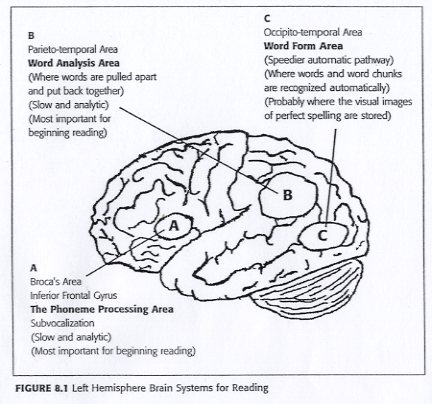Neural Systems for Reading
Nov 26th, 2010 | By dkrupke | Category: BrainAs more educators come to understand learning and the brain, teaching practices and strategies improve, benefiting all learners. The following is a brief summary of information from the work of Dr. Sally Shaywitz and Dr. J. Richard Gentry relative to brain systems for reading.
 Broca’s area (area A in Gentry’s diagram of the brain) is the Phoneme Processing Area. This is where subvocalization occurs . . a process that is slow and analytical and most likely to be used in the beginning stages of learning to read, according to Shaywitz and Gentry. This area might be activated when a K teacher has children shouting out the rhyming word in a nursery rhyme as they repeat a part in unison. Broca’s area is also the “speech” area, dealing with articulation . . . how sounds are formed in the mouth.
Broca’s area (area A in Gentry’s diagram of the brain) is the Phoneme Processing Area. This is where subvocalization occurs . . a process that is slow and analytical and most likely to be used in the beginning stages of learning to read, according to Shaywitz and Gentry. This area might be activated when a K teacher has children shouting out the rhyming word in a nursery rhyme as they repeat a part in unison. Broca’s area is also the “speech” area, dealing with articulation . . . how sounds are formed in the mouth.
The second area of importance is the Word Analysis Area in the parieto-temporal area of the brain (area B). This is where words are pulled apart and put back together, in essence, linking sounds to letters. It is my belief that the use of Visual Phonics hand shapes helps to activate this area. This is also slow and analytical . . . most important for beginning reading, according to Gentry. Shaywitz and others state that this is the area responsible for word analysis or sounding out words. Gentry believes this area is important for the beginning phases of invented spelling. Gentry states that activity in these first two areas is the most important for the beginning phases of reading and writing.
Area C is referred to as the Word Form Area. This is a speedier automatic pathway, where words and word chunks are recognized automatically. Gentry feels that this is where the visual images of perfect spelling are stored. Shaywitz states that the activation of the “word form area” leads to the “express pathway of reading”. Gentry (2004) states that activation of this area, for most skilled readers, is basic for recognizing words automatically and perhaps for visual recognition and recall of spelling patterns.
Gentry (2007) goes on to say . . . “the mapping of print-to-spoken language in English likely includes not only letter-to-sound but also chunk-to-chunk mapping. It follows then, that the Word Form Area may be completely activated once children recognize enough sight words and have enough word-specific and chunking knowledge to see the patterns in print automatically. Activation of the Word Form Area, the speedier pathway, allows children eventually to process new words after a few repeated exposures in meaningful context.”
Gentry, J. R. (2007). Breakthrough in Beginning Reading and Writing. New York: Scholastic.
Shaywitz, S. (2003). Overcoming dyslexia. New York: Knopf.
Note: The brain diagram, Figure 8.1 Left Hemisphere Brain Systems for Reading, can be found on page 84 of Richard Gentry’s work entitled, “Breakthrough in Beginning Reading and Writing” and is used with permission of Scholastic Inc.
© 2010 Dave Krupke All Rights Reserved
Leave a Reply